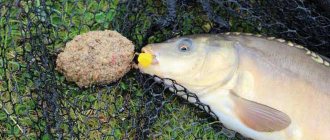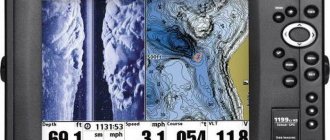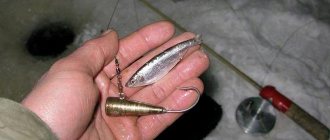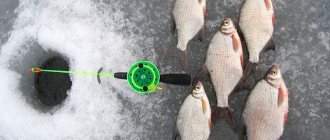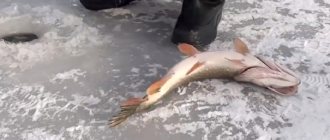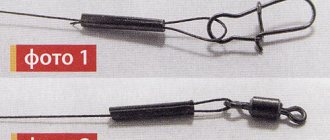Tips on the habits and preferences of fish
Color and light for fish
In water, fish distinguish colors well. Its red color is especially attractive, so fishermen tie a bunch of red threads on a hook when catching a predator. And for leucorrhoea, maggots are painted red.
Night light attracts catfish, roach, and burbot. Often, when fishing, fishermen specially light a fire on the shore. Carp, on the contrary, is afraid at night and moves away from the light.
The fish treats white hooks with caution. It is advisable to mask them with a nozzle - cover them completely, or not use them at all.
Weather for fish
When atmospheric pressure decreases, fish rise upward. It is worth catching it in the upper layers of water. When pressure increases, it stays at depth, closer to the bottom.
Steady atmospheric pressure, a slight western or southwestern wind, all other things being equal, can provide a bite and a good catch of fish.
The fish bite noticeably deteriorates when a thunderstorm approaches. Afterwards, especially with warm, rare rain, the bite is restored and even intensifies.
In extreme heat, the fish stays in cool water - under steep banks, deep cliffs, near springs.
When the water level is stable, the fish stick to feeding areas and bite well.
When the water decreases, the fish move away from the shore and deeper, and the bite weakens significantly or disappears completely. When the level normalizes, the fish calms down and the bite resumes.
The increase in water also worsens the bite. The fish scatter around newly flooded areas rich in food and show little interest in fishermen’s baits.
Tips for beginners and experienced fishermen
A few basic tips will help inexperienced anglers catch their prey.
How to keep your hook sharp
The sharpness of hooks depends on the technology of their production. The sharpest hooks are those made by a Japanese manufacturer (Gamakatsu, Owner, Suehiro, etc.). Japanese products do not require additional sharpening.
If the angler believes that the hook has become insufficiently sharp, then first of all it is necessary to remove the varnish coating on the tip. You can sharpen the hook using sanding paper glued to a wooden ruler or board.
How to keep your fish fresh until the end of the session
Caught fish should always be carefully released from the hook so that it does not get hurt. If the caught specimen deeply swallowed the bait with a hook and the fish had to be seriously injured, then it is not recommended to place it in a fish tank or bucket with the catch. In this case, it is better to kill the fish, sprinkle with salt and place in a cool place.
The cage containing the catch must be checked regularly. If one specimen has fallen asleep or floated upside down, then it is better to isolate it from the rest.
During the hot summer months, the cage must be in the shade, as the fish will not survive long in warm water and open sun. If you don't take care of it, fishing will destroy it.
Non-standard predator baits
Devons are propeller-type spoons, the length of which does not exceed 5 cm. This attachment is used for catching predators in the upper layers of water, but some models allow you to retrieve near the bottom. Devon consists of a hollow body, 2 blades, an axle rod, a carabiner, a bead and a tee.
The bait, called a banjo minnow, is made from materials that are neutrally buoyant. This homemade product for do-it-yourself fishing is attached to a single hook with a specific shape. The game of such a bait is very different from other types of predator baits.
We catch trophy fish on a donk
The best bait for bottom fishing is a bunch of worms. They can be rain, dung or white. The crawlers, which reach large sizes and attract large fish, deserve special mention.
The best bait for catching carp and large crucian carp is canned corn. There are several ways to hook corn, but it is best to thread it so that the tip of the hook is visible.
Secrets of breeding maggots at home
Meat waste, fish or other organic matter should be placed in any suitable container. The container must be placed in a dark and cool place accessible to flies. After 2-3 days, the insects will lay eggs, after which the container must be closed with a lid with holes for ventilation.
After the larvae reach the desired size, they are transferred to sawdust, where they get rid of the unpleasant odor. You need to store maggots in the refrigerator, because otherwise they begin to pupate.
Fishing Tips by Type of Fish
It is enough to open the first fish caught to find out what it is feeding on at this time.
The fish does not see the angler and takes the bait more confidently if there are small ripples on the water.
To silently cast a spinner using a rod with an inertial reel, the cast is made along a flat trajectory. Before the bait touches the water, use your finger to slow down the rotation of the reel while slightly lifting the tip of the stick.
Pike
When going fishing for pike, you should stock up on metal leashes. In this case, the spotted fish will not be able to cut the line and leave.
The pike waits for its prey in ambush, rather than prowling around the pond. If the spotted one was seduced with bait and caught, then a few days later another pike will settle in the same place.
Perch
If you suddenly find yourself in the presence of a school of large perch, you can expect a good catch. However, on one condition. Not a single perch should fall off.
The best time to catch perch is in the morning and during the day. In the evening, the predator, as a rule, having had enough for the day, is not so willing to take bait.
Bream
If the bream bite is unstable or disappears, move the bait on the bottom from time to time with a light movement of the fishing rod. The fish will respond better to movement in the water and become interested in the bait.
Tips for fishing in difficult conditions
A beginner is afraid to fish in places covered with duckweed and algae, since he is not sure that he will hit the window exactly. But in such conditions the fish bite more actively.
A fly rod allows you to lower the tackle directly to the target, so it makes sense to purchase such a rod for fishing crucian carp among aquatic vegetation.
The predator also stays where a novice spinner will have a hard time. The favorite places of pike perch are snags. A pike stands in a thicket of algae. In both cases, snags are inevitable.
For a beginner who does not yet feel the tackle, non-snagging baits will be useful. You shouldn’t expect them to pass a serious obstacle, but in most cases they will help to avoid the gear breaking.
Tips for fishing from a boat
While inflating the rubber boat in the cool morning, during the day, when the temperature rises, release excess air. This will prevent the balloon from heating up and increasing its volume. Most water accidents happen for this reason.
Do not overload the boat or place poles on the floor of the rubber boat. Do not throw fishing rods, lures, hooks or any sharp objects to avoid damaging the cylinder and the areas where it connects to the floor.
When going on a boat, be sure to take with you a repair kit, a spare oar and a rowlock.
Do not ignore legal requirements and advice from fishermen about a life jacket. Every person on the boat must wear a life jacket
In the event of an accident, you should not climb onto an overturned boat; it will inevitably capsize. It is best to hold on to the bow or stern and push it towards the shore, paddling with one hand and dangling your legs in the water
If a thunderstorm finds you in a boat, it is better to lie on the bottom and cover yourself with a raincoat. Standing in a boat, especially in the middle of a body of water, is dangerous.
You cannot get close to a rubber boat with pilings and bridges - nails may stick out under the water
When mooring to the shore, exercise caution, especially on a rubber boat. Underwater at the bottom there may be sharp stones, glass, cans - there is a high risk of damage to the boat or puncture of the cylinder
Catching crucian carp with a feeder
Have you ever seen kilogram crucian carp walking in shallow water at depths of 30-50 cm?! The impression is as if you are at a nuclear submarine base - humps stick out above the water, whirlpools, a sight not for the faint of heart. All events take place 15-20 meters from you. What to do?
I take a light feeder for fishing and throw it there to them. Although the feeder is miniature, it splashes noticeably, and these guys immediately calm down. You think you've scared the day away! But no, after about ten minutes the fish’s movement resumes, as if sideways, but towards the food, I’m all ears, and here it is, the pull, hurray, the hook has taken place! While the crucian carp is knocked down, you drag it a few meters, and then it comes to its senses, turns on the engine and rushes to the side, usually into the grass or reeds. It is not difficult to guess how events will develop further. Running along the shore with advisers, frantic attempts to bring the fish out of the tents, putting on a wading suit, quickly moving towards a meeting with the long-awaited trophy, but you fall into the silt up to your chest, in the end, after many attempts, you find yourself at the place of the appointed meeting, but the client has left! And such feelings are overwhelming, words cannot describe them!
My opinion is that the most difficult way to catch crucian carp is with hooks and the like. gear, because its reactivity is known, and at the highest gear ratios on the reel it turns out to be more agile. Because of this, I rarely use hooks in the summer, although it’s not for everyone, many people only catch fish with hooks.
Feeder fishing for crucian carp - universal feeder tackle!
On tightening
The weather itself can dictate the best way to catch crucian carp. So, in a gusty wind, ripples are driven across the water. At this time (especially after hot days) it makes sense to try fishing on clean runs in the retrieve - the line pulls the float in an arc, the load can drag along the bottom, or only the hook can touch the ground; sometimes, especially along the algae, it generally takes well in half-water. Bites during such fishing are usually confident and, which rarely happens with crucian carp, you can successfully catch from one place all day, it does not get tired of fishing attention.
One maggot is good, but half a maggot is excellent!
Experiments and more experiments lead to successful crucian fishing. It would seem, what else can you come up with with such an attachment as the well-known maggot. Closer to autumn, with the first cold snaps, when the crucian carp's basic reflexes are slowed down, and in general, when the bite is bad, I pinch a couple of maggots on the hook. Sometimes I go even further - I cut off half the larvae with sharp scissors, and sometimes this is the only thing that revives the bite.
Useful tips on tackle and rigging
Rod
A soft rod absorbs the jerks of strong and large fish well, but does not always allow you to spot the fish well. The rigid rod reliably hooks easily through the bony mouth of the pike or pike perch.
The tight connecting tubes of the fishing rod should be rubbed with soap before assembly. This way you can easily connect the tubes and assemble the rod.
When the connecting tubes are jammed and it is impossible to disassemble the elbows, simply warm the metal rings with a lighter or match. The knees will fold easily.
Hooks
Hooks should be selected according to the color of the bait.
Before fishing, you need to check the condition of the hooks. If there is any suspicion of poor quality, they should be replaced with new ones.
Do not store hooks in metal boxes. They will certainly become dull.
You cannot stick hooks into the rod, into plastic, even soft ones. They will quickly become unusable.
Hooks may rust if stored for a long time. To prevent this from happening, you need to add a little starch to the box with them. If they are already rusty, you should stick them in soap. In a few hours the hooks will be as good as new.
After fishing, do not forget to clean the bait from the hooks. This way they will last longer and will not rust.
Types of spinning reels

The reel also plays an important role in spinning tackle. As experienced fishermen say, the reel is 60% of the entire tackle. They are divided into two types: with a front friction brake and with a rear one. A friction brake is a mechanism designed so that in the event of a sharp jerk, snag, or other conditions, the reel will release the line, and thus excessive pressure will not be generated, and your tackle will not break. When choosing a reel, the first thing you should pay attention to is the size of the spool, its line or cord capacity, depending on what you will be fishing for, and, accordingly, the number of bearings. There is an opinion that if there are a lot of bearings, then it is good. For expensive reels this is really good, but for inexpensive ones it means extra weight and the possibility of the reel being damaged. For any beginner, 4 bearings are sufficient to the fullest. All the characteristics of the reel can be found on the reel spool: gear ratio, spool capacity.
Tips on baits, baits, groundbait
The stronger the smell of the attractant or aromatic substance, the smaller the dose needed to flavor the bait.
Just one aspirin tablet will preserve the freshness of the vegetable attachment for a long time if you add it to porridge or dough when cooking.
To ensure a firm seat on the hook, you need to add a little cotton wool to the bread crumb attachment. The nozzle will not get lost even in strong currents.
Zywiec
If the bleak - live bait is dried a little, then the scales will not fall off much when the fish is attached to the tackle.
Ruffs and perches should not be stored in the same container with other live bait fish. Perches damage them with their needles, and ruffs poison them with their mucus.
Choosing bait and developing tactics
The main question for a beginner is what to put on the hook. Each body of water has its own recipes, but the general rule is:
- in cold water baits of animal origin work better;
- on warm - vegetable attachments.
This is not a dogma, we need to experiment. If you don’t bite pearl barley in the summer, replace it with maggot or caddisfly.
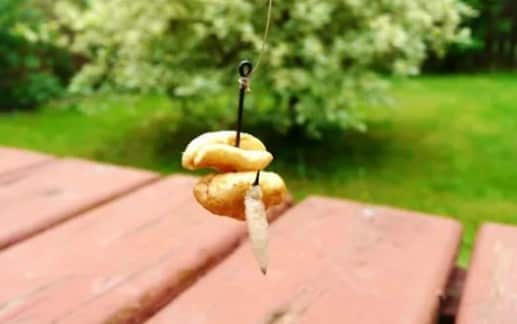
Like sports, fishing requires practice, so don't be shy about perfecting your casting technique. This is easier to do where there are no obstacles in the form of coastal bushes and trees.
Organize the first couple of trips to a reservoir with a clean water edge, not overgrown or snags. The goal is to learn how to throw tackle at a distance of 50 m.
Some manage to train at their summer cottage. Also an option. To do this, place a container of water at a specified distance and try to get into it.
